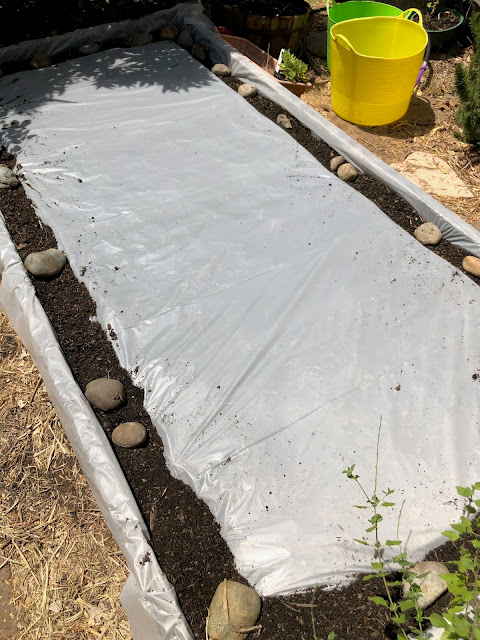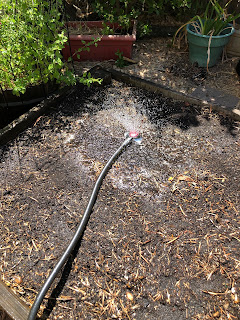
Now's the best time for soil solarization

|
|
Here's my raised bed, all ready for the sun to do its work.
(Photos: Kathy Morrison) |
There's at least one good thing about our hot, no-rain summers: We can easily put the sun to work for us in the garden, solarizing our soil.
Why solarize? It's a natural way to control pests, pathogens and weeds.
My first 4-by-8-foot raised bed was built 20 years ago on the south side of our small backyard. This replacement bed, constructed with better lumber, is 18 or 19 years old. It was my tomato-growing workhorse site for a few years, until I joined my local community garden and moved tomato production there.
Since then the raised bed has had an erratic production history. Beans did well for awhile, and peppers two years. Onions went in at least one year. I most recently had strawberry plants there, but they were not happy and died more often than not. The survivors were moved to grow bags, where they are doing well.
Since I didn't have to plant anything in the home raised bed this year, I decided to try solarizing it to kill off any lingering pathogens (such as wilts), weed seeds or nematodes. We had an overgrown podocarpus tree nearby removed earlier this year, clearing the way for an intense solarization experience.

|
|
The soil needs to be soaked first for
solarization to work. Those remaining
podocarpus leaves also have to go. |
-- Remove any debris from the site and rake it flat.
-- Water it well, down at least 12 inches.
-- Dig trenches along the edges where the plastic will be anchored.
-- Cover tightly with plastic; anchor the plastic with soil (and rocks, in my case).
-- Wait four to six weeks (or more) for the sun to do its work.
-- Uncover and plant. (Though I likely will do a soil test before I put any plants in.)
The plastic sheet I used is 1.5 mils thick, which is within the recommended range for durability. It's not perfectly clear, but clear enough. Black or colored plastic is not recommended. Rolls of clear plastic can be found at most home improvement stores -- look in the paint section.
My raised bed's been set up for a week now. The soil temperature's already up to 98 degrees and the underside of the plastic shows many nice bubbles.
I'll report back later in the summer on my progress. Meanwhile, here's a great guide to solarization from the UC Integrated Pest Management program, if you want to try it. If a video is more useful to you, the Sacramento master gardeners filmed a solarization guide for the 2020 Virtual Harvest Day; see it here .
Comments
0 comments have been posted.Sacramento Digs Gardening to your inbox.
Sites We Like
Garden Checklist for week of April 21
This week there’s plenty to keep gardeners busy. With no rain in the immediate forecast, remember to irrigate any new transplants.
* Weed, weed, weed! Get them before they flower and go to seed.
* April is the last chance to plant citrus trees such as dwarf orange, lemon and kumquat. These trees also look good in landscaping and provide fresh fruit in winter.
* Smell orange blossoms? Feed citrus trees with a low dose of balanced fertilizer (such as 10-10-10) during bloom to help set fruit. Keep an eye out for ants.
* Apply slow-release fertilizer to the lawn.
* Thoroughly clean debris from the bottom of outdoor ponds or fountains.
* Spring brings a flush of rapid growth, and that means your garden is really hungry. Feed shrubs and trees with a slow-release fertilizer. Or mulch with a 1-inch layer of compost.
* Azaleas and camellias looking a little yellow? If leaves are turning yellow between the veins, give them a boost with chelated iron.
* Trim dead flowers but not leaves from spring-flowering bulbs such as daffodils and tulips. Those leaves gather energy to create next year's flowers. Also, give the bulbs a fertilizer boost after bloom.
* Pinch chrysanthemums back to 12 inches for fall flowers. Cut old stems to the ground.
* Mulch around plants to conserve moisture and control weeds.
* From seed, plant beans, beets, cantaloupes, carrots, corn, cucumbers, melons, radishes and squash.
* Plant onion sets.
* In the flower garden, plant seeds for asters, cosmos, celosia, marigolds, salvia, sunflowers and zinnias.
* Transplant petunias, zinnias, geraniums and other summer bloomers.
* Plant perennials and dahlia tubers for summer bloom.
* Mid to late April is about the last chance to plant summer bulbs, such as gladiolus and tuberous begonias.
* Transplant lettuce seedlings. Choose varieties that mature quickly such as loose leaf.